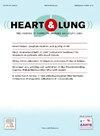Pulmonary arterial stiffness and vascular tone in pulmonary hypertension: Insights from waveform-derived reflection index and hemodynamic correlations
IF 2.4
4区 医学
Q2 CARDIAC & CARDIOVASCULAR SYSTEMS
引用次数: 0
Abstract
Background
Pulmonary hypertension (PH) involves increased arterial stiffness and reduced vascular tone, affecting pulmonary arterial wave reflections. The Reflection Index (RI) may provide insights into these changes.
Objective
This study examines the utility of RI in PH patients by correlating it with key right heart catheterization (RHC) parameters.
Methods
Patients who underwent RHC with a preliminary diagnosis of PH, including those with normal RHC findings and those diagnosed with Group 1 and Group 4 PH, were included in the study. RI was defined as the ratio of systolic to diastolic pressure differences from pulmonary arterial waveforms and compared with hemodynamic, clinical, and echocardiographic parameters.
Results
The study included 115 patients (mean age 53.92 ± 16.43 years; 43.5% male). RI showed significant correlations with key RHC parameters, such as sPAP (r=0.359, p<0.001), dPAP (r=0.322, p<0.001), mPAP (r=0.339, p<0.001), PVR (r=0.431, p<0.001), and pSO2 (r=-0.243, p=0.011). Among echocardiographic measures, RI correlated with TRV (r=0.377, p<0.001) and echo sPAP (r=0.359, p<0.001). In multivariable analysis, RI (OR:1.032, p=0.003) and NT-proBNP (OR:1.004, p=0.049) remained significant predictors of PH. ROC analysis demonstrated the moderate predictive power for RI (AUC=0.806, p<0.001), with 76.4% sensitivity and 78.5% specificity at a cut-off of 232.05.
Conclusion
RI is a valuable parameter for assessing pulmonary arterial stiffness and vascular tone in patients with PAH and CTEPH. Significant correlations were observed with key hemodynamic parameters, including PVR and mPAP. Additionally, RI demonstrated moderate predictive power for PH. These findings highlight the potential of RI as an independent marker of vascular health, providing direct insights into the pulmonary arterial bed.
肺动脉僵化和肺动脉高压的血管张力:从波形衍生反射指数和血液动力学相关性中窥探一二。
背景:肺动脉高压(PH)会导致动脉僵化和血管张力降低,从而影响肺动脉波的反射。反射指数(RI)可能有助于了解这些变化:本研究通过将 RI 与右心导管检查(RHC)主要参数相关联,探讨 RI 在 PH 患者中的应用:方法:研究对象包括接受右心导管检查并初步诊断为 PH 的患者,包括右心导管检查结果正常的患者以及被诊断为 PH 第 1 组和第 4 组的患者。RI被定义为肺动脉波形的收缩压与舒张压差值之比,并与血液动力学、临床和超声心动图参数进行比较:研究共纳入 115 名患者(平均年龄为 53.92 ± 16.43 岁;43.5% 为男性)。RI 与 RHC 主要参数(如 sPAP)有明显相关性(r=0.359,p):RI 是评估 PAH 和 CTEPH 患者肺动脉僵化和血管张力的重要参数。观察到 RI 与包括 PVR 和 mPAP 在内的主要血流动力学参数存在显著相关性。此外,RI 对 PH 具有中等程度的预测能力。这些发现凸显了 RI 作为血管健康独立标记物的潜力,为肺动脉床提供了直接洞察力。
本文章由计算机程序翻译,如有差异,请以英文原文为准。
求助全文
约1分钟内获得全文
求助全文
来源期刊

Heart & Lung
医学-呼吸系统
CiteScore
4.60
自引率
3.60%
发文量
184
审稿时长
35 days
期刊介绍:
Heart & Lung: The Journal of Cardiopulmonary and Acute Care, the official publication of The American Association of Heart Failure Nurses, presents original, peer-reviewed articles on techniques, advances, investigations, and observations related to the care of patients with acute and critical illness and patients with chronic cardiac or pulmonary disorders.
The Journal''s acute care articles focus on the care of hospitalized patients, including those in the critical and acute care settings. Because most patients who are hospitalized in acute and critical care settings have chronic conditions, we are also interested in the chronically critically ill, the care of patients with chronic cardiopulmonary disorders, their rehabilitation, and disease prevention. The Journal''s heart failure articles focus on all aspects of the care of patients with this condition. Manuscripts that are relevant to populations across the human lifespan are welcome.
 求助内容:
求助内容: 应助结果提醒方式:
应助结果提醒方式:


